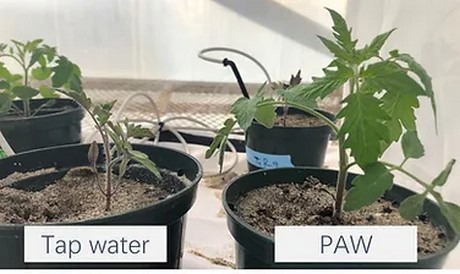Using cold plasma-generating technologies, atmospheric gas is ionized and injected into water, creating plasma-activated water (PAW for short). The resulting PAW solution possesses characteristics that have peaked the interests of CEA growers worldwide: 1) high concentration of dissolved nitrogen, 2) ability to enhance seed germination and seedling vigor, 3) protection against biotic and abiotic plant stressors, and 4) antimicrobial properties (fungicidal, bactericidal). Moreover, PAW inputs include water, air, and electricity; creating an eco-friendly product that is free of industrialized synthetic chemicals.
 Tomato plants in containers in which the fertigation program was supplemented with tap water or PAW. University of California, Davis
Tomato plants in containers in which the fertigation program was supplemented with tap water or PAW. University of California, Davis
This technology is becoming commercially available and adopted by large greenhouse operations around the world, but there are still open questions and challenges to be addressed. Recently, a group of scientists from multiple universities within the United States and key cold plasma industry members met online to discuss fundamental and applied aspects of PAW. During the meeting, participants discussed several topics including a recently conducted survey in which CEA growers were asked questions regarding their willingness to adopt PAW in their operations. Additionally, the stability of PAW over time as a function of storage conditions was discussed in detail from an analytical perspective. The meeting also includes a comprehensive presentation on how irrigation of tomato plants with PAW can boost indirect plant resistance mechanisms to spider mites – this study was recently published and is freely available online (https://doi.org/10.1007/s10340-024-01791-0).
If you are interested in sustainable crop production and frontier technologies and want to learn more about PAW – you're in luck! This meeting was recorded and will give you a comprehensive introduction as well as valuable insights into PAW! To access the recorded video of the meeting, click this link: https://youtu.be/zJjyTEdNqxU
If you still have a hankering for more information on PAW, please visit the project website on which newsletters, meeting recordings, and other materials are becoming available: https://chrnansen.wixsite.com/nansen2/cold-plasma-1
Source:umn.edu
